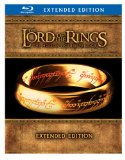| Reviews & Columns |
|
Reviews DVD TV on DVD Blu-ray 4K UHD International DVDs In Theaters Reviews by Studio Video Games Features Collector Series DVDs Easter Egg Database Interviews DVD Talk Radio Feature Articles Columns Anime Talk DVD Savant Horror DVDs The M.O.D. Squad Art House HD Talk Silent DVD
|
DVD Talk Forum |
|
|
| Resources |
|
DVD Price Search Customer Service #'s RCE Info Links |
|
Columns
|
|
|
Lord of the Rings Trilogy: Extended Editions, The
New Line // PG-13 // June 28, 2011
List Price: $119.98 [Buy now and save at Amazon]
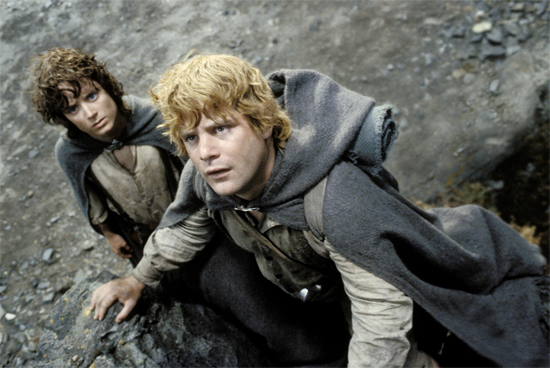
Waxing poetic about Peter Jackson's Lord of the Rings trilogy almost seems like a moot point; it's achieved high-balled box office success, garnered a slate of Academy Awards, and left movie-goers spellbound by its whimsical, dark, alluring construction. After close to four years of hardcore development strains, the New Zealand director cranked out a series of adaptations on J.R.R. Tolkien's books that brought fantasy back to the modern era -- a period where the likes of Gladiator and Braveheart had reinvigorated the epic-scaled picture, bringing the genre back into the spotlight. The path to creating the films, all three shot back-to-back in New Zealand, was about as arduous as Frodo's journey to destroy the "one ring", but the end result was well worth the trial.
Moreover, what Peter Jackson created with his series was an appointment-worthy franchise that arrived every holiday season for three years straight, from '01 to '03. It became a tradition with our little clan to have a calorie-rich meal at a nice restaurant before venturing into the world of Middle-earth, building into a night of clanking swords, magical effects, and a sweeping story that continued almost seamlessly throughout the series' dominant theatrical run -- where it garnered over one billion dollars domestically. The anticipation seemed to happen almost instantaneously, though; promotional artwork and trailers spilled into the mainstream quickly, and it throttled the excitement for the first picture like the spark of a flame for fans of the fantasy picture. More importantly, Peter Jackson never falters in delivering exactly what was expected: thrilling, dazzling fun.
Jackson stated in an interview that he had always hoped someone would bring Tolkien's trilogy to the big-screen, and his passion for the material clearly shines through his body language and the tone of his voice when stating so. It also shows in the wealth of research, material and effort he and his crew poured into the creations, some of which couldn't fit into the confines of the theatrical releases that graced screens during those holiday seasons. Thus, Peter Jackson unleashed the handsome Extended Editions of his grand fantasy works, which stitched excised footage back into the main feature and contained an astronomical amount of supplements for those curious about its conception. These aren't simple repackaging jobs that smack of a company reaching back into a cookie jar, but expansive and comprehensive documents that speak directly to its loyal audience -- and exist as some of the home-video format's finest releases. Warner Bros. and New Line, after dropping the theatrical cuts of the Lord of the Rings trilogy on Blu-ray the previous year, now bring the Extended Editions to the high-definition arena, lugging the exhaustive, delightful baggage from previous offerings along with it.
An Overview of The Trilogy:
The Lord of the Rings focuses on Frodo (Elijah Wood), a hobbit from an idyllic little slice of paradise called The Shire, who must trek across the treacherous grounds of Middle-earth to destroy an all-powerful ring -- one that's linked to the life force of Sauron, an evil force on the rise to cover the world in darkness. He's accompanied by eight companions at first -- three other hobbits, an elf named Legolas (Orlando Bloom), the drawf Gimli (Jonathan Rhys-Davies), a warrior human named Boromir (Sean Bean), dormant king Aragorn (Viggo Mortensen) and the powerful wizard Gandalf (Sir Ian McKellen) -- who lead him a sizable chunk of the way, but happenstance calls for Frodo to continue the trek in vastly smaller numbers as the narrative progresses. Jackson's adaptation of the material attempts to cover a dense array of books' subplots, including the fate of Aragorn as the true ruler of the lands of Middle-earth, the relationship between men and elves, the existence of one of the ring's previous owners, Sméagol (Andy Serkis), and the fate of Theoden's leadership as the king of Rohan. All that on top of saving the world.
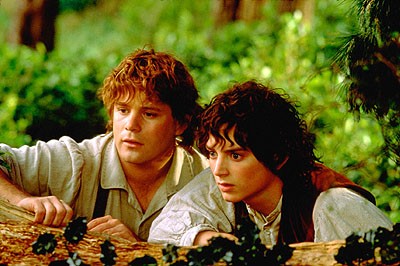 In The Fellowship of the Ring, Peter Jackson digs his heels into the broad mythology with grace. After a chill-inducing introduction to the events that occur before Frodo obtains the ring, including doom-swelling imagery of Sauron's mace-wielding destruction on the battlefield, he gives us a glimpse of the hobbits' home The Shire at a time of peace -- and how the ring at the root can cause distress even in this peaceful place. The film illustrates how men, elves, and hobbits alike surrender to its powerful draw, and why it's an instrument of equalization and earnest desperation that could cause the world to crumble based on the need for destructive, almost ubiquitous dominance over the lands. A necessary point in connecting with an audience comes in our ability to see the importance of the ring, not just as a link to the one-dimensionally evil Sauron but also as an alluring force that appeals to the hubris of dominance, and Jackson pins that down with the forces of good, neutral, and evil alike transfixed to its billowing lure.
In The Fellowship of the Ring, Peter Jackson digs his heels into the broad mythology with grace. After a chill-inducing introduction to the events that occur before Frodo obtains the ring, including doom-swelling imagery of Sauron's mace-wielding destruction on the battlefield, he gives us a glimpse of the hobbits' home The Shire at a time of peace -- and how the ring at the root can cause distress even in this peaceful place. The film illustrates how men, elves, and hobbits alike surrender to its powerful draw, and why it's an instrument of equalization and earnest desperation that could cause the world to crumble based on the need for destructive, almost ubiquitous dominance over the lands. A necessary point in connecting with an audience comes in our ability to see the importance of the ring, not just as a link to the one-dimensionally evil Sauron but also as an alluring force that appeals to the hubris of dominance, and Jackson pins that down with the forces of good, neutral, and evil alike transfixed to its billowing lure. Drenched in forest greens through Andrew Lesnie's heavily manipulated cinematography and carried by the production from Jackson's WETA Workshop / Weta Digital design houses, there's a sense of discovery about Middle-earth in The Fellowship of the Ring that's magical. It takes us through scenes in The Shire, along the road to the elvish land Rivendel, and through the dark mines of Moria in a fresh manner, witnessing the locations whittled out by J. R. R. Tolkien coming to life in a way that could only be done with this mix of digital and tangible effects. Sure, Peter Jackson could've made use of found locations in New Zealand on their own, along with the costume and make-up work, but his background with lurid madness in Dead Alive and animated fancy within his childhood drama Heavenly Creatures leads the Kiwi director to attempt an engulfing and creative vision -- and, boy, does he get it right.
What differs The Fellowship of the Ring from the other films in the series is its focus on character history and mythos instead of popcorn-munching, full-throttle excitement, built in a introductory way appealing to grand storytelling and a superb mix of theatrics and action. We're getting to know these characters before they're rooted in their archetypes, something that's a necessary evil as the storyline progresses; affection is built for them as the storyline throttles forward with swords clanking and magic soaring, but it's only after we've sorted out their "alignment" for ourselves -- Gimli's reluctant determination, Boromir's easily-swayed need for power, and Aragorn's unyielding allegiance. The presence of Sauron and his white wizard henchman, Saruman (Christopher Lee), lean on mysteriousness to us at this point, and the novelty of their darkness pairs well with the discovery of the ways our lead characters' act and react. It's, well, like reading the first chapters of a great book, with entities interwoven in a bleak yet hopeful environment. Because of its skill in kick-starting both the visual and textual construction of this mythic world, and igniting our fascination with it, it's easy to acknowledge this installment as the most finely-crafted of the trilogy.
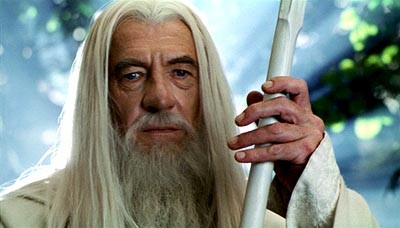 Jackson must've known that The Fellowship of the Ring would construct a bleak foundation underneath the feet of the characters, because The Two Towers quickly leads into more robust pacing and consistent, enthralling action sequences to liven the mood, for better or worse. It finds the Fellowship separated and the mystery behind the ring's history being partly revealed through our interaction with its past holders, but it also allows its characters to find a comfort zone in their demeanor. Frodo spirals further into the bleak control of the ring as Samwise aides his journey, Aragorn takes the reigns as a chivalric warrior inching his way towards becoming a king, and the rest of the fellowship leans on the mannerisms that suit them best as Gandolf experiences a shift in consciousness. Legolas remains stoic yet warming, Gimli becomes more of a comic relief, and the twosome of Merry (Dominic Monaghan) and Pippin (Billy Boyd), mostly separated from the rest of the characters in this installment, show their worth while remaining foolishly oafish. Development of character isn't paramount in this middle-ground entry in the story, at least not for the primary characters.
Jackson must've known that The Fellowship of the Ring would construct a bleak foundation underneath the feet of the characters, because The Two Towers quickly leads into more robust pacing and consistent, enthralling action sequences to liven the mood, for better or worse. It finds the Fellowship separated and the mystery behind the ring's history being partly revealed through our interaction with its past holders, but it also allows its characters to find a comfort zone in their demeanor. Frodo spirals further into the bleak control of the ring as Samwise aides his journey, Aragorn takes the reigns as a chivalric warrior inching his way towards becoming a king, and the rest of the fellowship leans on the mannerisms that suit them best as Gandolf experiences a shift in consciousness. Legolas remains stoic yet warming, Gimli becomes more of a comic relief, and the twosome of Merry (Dominic Monaghan) and Pippin (Billy Boyd), mostly separated from the rest of the characters in this installment, show their worth while remaining foolishly oafish. Development of character isn't paramount in this middle-ground entry in the story, at least not for the primary characters. Two new plot points, the faded rule of Rohan and the presence of previous ringbearer Sméagol, take a central, clean spotlight in The Two Towers as the network of secondary plots convolute outside of Frodo's journey towards Mount Doom -- the central drive behind the films that's, ultimately, unconnected to much of the other happenings. King Theoden (Bernard Hill), a once-powerful ruler, has been bewitched by one of Saruman's minions to a point of near-death inertia, plaguing his rule so much that he's blinded even to the allegiance of his family. The township's importance to the story mostly roots in the state of humankind underneath Sauron's thumb, and what it'll be like if he tightens his grasp. On top of that, we're given an intimate conflict between Frodo, Samwise, and the slithering presence of Sméagol -- brought to life with still-impressive clout by a combo of Andy Serkis' vocal / bodily performance and the massively impressive digital make-up of his gaunt body -- as the ring's power to contort those around it becomes more and more evident within their murky, cerebral twists on mental turmoil and allegiances.
Bilbo Baggins uses a metaphor in The Fellowship of the Ring that properly describes The Two Towers: he refers to the way he feels as a piece of bread with butter spread too thin on top. This second installment into the Lord of the Rings trilogy feels as if the thematic materials from the first and third films are simply stretched over into the contents of this second picture, while raucous battles and dazzling special effects increase in frequency as if to fill in the gaps. Computer-generated grandeur, including renderings of wild dog-like beasts and legions upon legions of Orcs, is used more as a device for spectacle instead of seamless storytelling; it satisfies our eyes, yet its persistence wears thin as the unfurling story wains. Some of it even borders on the absurd and unbelievable, such as a scene involving a charge of horses late in the picture; however, the competent construction and steadfast fervor behind Jackson's vision persevere and still craft this into an ample and deserving motion picture. It's more about a collection of moments that thrillingly drag us to the third installment by our bootstraps.
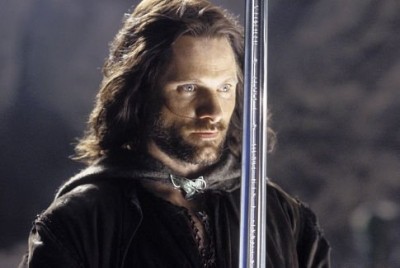 A lot of momentum leads into The Return of the King, the mammoth conclusion to the Lord of the Rings saga, where we've developed a sense of hope for the fate of Middle-earth as Frodo and his companions see the billowing lava of Mount Doom growing closer and closer. The sensation concocted by Jackson to this point is somewhat compelling and different, as the threat of Mordor and Sauron's minions offer more of a benchmark villain to be conquered than a force to be feared. Our morale ebbs and flows with the rest of Middle-earth's disparate yet unfaltering denizens, which center on the fate of mankind in several different locations -- Gondor, Rohan, and the massive flagpole keep of Minas Tirith -- as a war brews between good and evil. What questions we have left are primary to the storyline: how will Frodo scale Mount Doom and destroy the ring, will the visions seen of Minas Tirith engulfed in defeatist flames come true, and will Aragorn finally take his rightful place as king and lead his people to salvation?
A lot of momentum leads into The Return of the King, the mammoth conclusion to the Lord of the Rings saga, where we've developed a sense of hope for the fate of Middle-earth as Frodo and his companions see the billowing lava of Mount Doom growing closer and closer. The sensation concocted by Jackson to this point is somewhat compelling and different, as the threat of Mordor and Sauron's minions offer more of a benchmark villain to be conquered than a force to be feared. Our morale ebbs and flows with the rest of Middle-earth's disparate yet unfaltering denizens, which center on the fate of mankind in several different locations -- Gondor, Rohan, and the massive flagpole keep of Minas Tirith -- as a war brews between good and evil. What questions we have left are primary to the storyline: how will Frodo scale Mount Doom and destroy the ring, will the visions seen of Minas Tirith engulfed in defeatist flames come true, and will Aragorn finally take his rightful place as king and lead his people to salvation? We receive answers to these questions in grand fashion, as Jackson leads us into the conclusion to this story arc with confident, balls-out abandon and gut-wrenching visuals. Emotions intensify between Frodo and Sméagol as their interpersonal war for the ring grows thicker, offering a clever mental struggle that never falters to capture our attention amid its manipulation. As they scale rocks and sludge through the dark recesses near the mountain, including within a deadly spider's lair, their exhaustion offers a reminder that their road's not an easy one. Aragorn, Legolas,and the rest might be shooting arrows and lopping the heads off of Orcs amid the strikingly crafted contours of Minas Tirith, but the central battle for mental control over the ring becomes the paramount -- and potent -- driving force behind the suspense generated in The Return of the King. That's not to lower the value of the grand battles, which grow even broader in scope than those in The Two Towers; oddly, as the creatures grow more whimsical and massive here, the concentration on the battles' intensity achieves a tighter draw power. Giant "evil" elephants destroy legions of Middle-earth's good-willed fighters, giant winged lizards swoop above our heads, and massive boulders plaster holes into the walls of an otherwise-indestructible keep, but the liveliness behind it all makes it so that we're able to evocatively grab hold of this grandiose construction -- even relish in its sturdy ability to be so darned massive in scale.
The Return of the King earned 11 Academy Awards, including Best Picture, but they're more acknowledgements for the entire series than they are for this film's singular accomplishments. That's not to say that The Return of the King isn't a worthwhile deserver of the crown, because the breath-snatching momentum leading up to the last chivalric moments give a pointed and exciting conclusion to an exhaustive series of films -- nearly ten hours, from the first moments in The Shire to the final hurrah in Mordor. It takes a lot of skill to hold attention for that long a period, intermixing grand sword-crunching, arrow-flying battles with grotesquery, adult themes, a scattering of easy-to-digest cerebral complexity and an overall sense of victorious suspense for the people of Middle-earth, something that Jackson and his WETA crew and Wingnut production company concoct masterfully. Sure, there are one too many endings at the tail end of The Return of the King; however, would you really want this to end if you had created something so grandly successful? He does, reluctantly, and it all ends with an equally elegant and poetic conclusion that mirrors our first moments peacefully strolling through The Shire.
As with most fantasy film enthusiasts, I could subject you to all of the exquisitely detailed elements that Peter Jackson gets right within his Lord of the Rings Trilogy -- the sturdy pacing, stunning cinematography, and the cornucopia of characters that the films' actors flesh out to great lengths (including Cate Blanchett, Hugo Weaving, and Liv Tyler exquisitely embodying their elven characters) -- in textual, slug-you-over-the-head fashion. But it's easiest to sum it up with one simple statement: in areas where epically-scaled fantasy films have been misfiring for many, many years, this body of work hits them all in a potent, inspired fashion that, though lengthy and not word-for-word to Tolkien's work, is easy to return to time and time again. Some have approached the right blend of fantasy elements over the past thirty or so years, including The NeverEnding Story, Willow, Legend, and -- as of late -- the Harry Potter pictures, but Jackson's entrenched time in New Zealand recreating the Tolkien Trilogy culminates into the proper balance between all its moving parts. Watching this narrative stretch across its suspenseful, thoroughly impressive bridge to the end is what being a movie fan is all about: relishing in the swelling emotion, witnessing the grandness of imaginative construction, and, above all else, enjoying being engulfed in a smartly-handled, beautiful escapist realm where minutes feel like seconds.
So, these Extended Editions ...
Last year, The Lord of the Rings saw a Blu-ray release of the trilogy's theatrical cuts, and the choice against releasing the extended versions alongside the standard release caused a storm of anger from its loyal following. It takes a substantial difference to generate a response such as that, but Peter Jackson's elongated glimpses at Middle-Earth more than earn the clamoring; through seamless additions of removed scenes, complete with finished visual effects and graceful scoring extensions, these cuts finds new ways of making the viewer enhancing their appreciation the content, while also invigorating their flow with added nods to the novels themselves. Each one extends their respective film roughly forty to fifty (40-50) minutes in length, transforming the sweeping fantasy epics into even grander-scaled pieces of work that play to each individual film's strengths to highly proficient degrees. Furthermore, these points aren't just parlor tricks aiming to pander to fans; they also tailor the fabric of the films to more lucidly reveal more about the characters, motivations, and developments.
The highest compliment payable to the extended cut of The Fellowship of the Ring comes in stating that the pace of its theatrical iteration doesn't suffer whatsoever from the additions. As the smoothest, tonally complex and compelling of Jackson's creations, the potential to muck with its flow by distending its running time to over 200 minutes runs fairly high; however, the lengthier pieces added -- the extended intro into The Shire that illustrates the hobbits' nature to a finer degree, the content around Bilbo's mithril shirt and its worth, and the added emphasis on the gifts that Galadriel offers to the Fellowship's assorted members -- feel quite integral and necessary to the story's fabric, all snippets likely removed to bolster the film's pacing. On top of that, it also peppers in a few other quick character moments that mindfully inject personality to the rhythm, especially between Frodo and Gandalf (such as the ring-bearer asking his wizard guardian which direction to turn when starting his blind journey towards Mount Doom).
Some cinematic grievances exist in the very bones of The Two Towers that make it so it can't avoid feeling like an action-oriented bridge between installments, and Jackson's extended cut can't mask these issues. With added scenes, though, he does propel the vigorous action to a higher degree, while also reintegrating character-rooted bursts that attempt to even out the thematic imbalance and, in the process, improve upon the film's weak spots. Some offer marked upticks in the story's evocative strength, like an added conversation between Frodo and Sam about salt from The Shire, as well as a funeral scene in Rohan and a conversation between Eowyn and Aragorn about a disgruntled horse. The additional content revolving around Faramir, notably, works towards more quickly shaping the character into an intriguing entity, such as a beautiful dream-like vision of his brother coasting in a boat and a flashback to just before Boromir sets off to Rivendell. Others, though, invoke more charm than cohesiveness, such as the extended time spent with Merry, Pippen, and Treebeard, notably a scene where the two hobbits drink water and make themselves grow. Enhancements can assuredly be found, even in its more capricious flourishes, and The Two Towers elevates to a stronger, albeit still-flawed picture for it.
Already the lengthiest installment of Jackson's saga and the crown winner of Best Picture at the Academy Awards, The Return of the King stands the most to lose by adding a greater amount of material to its already-broad runtime -- clocking in at over four hours for this extended edition, extended by fifty (50) minutes. The material, oddly enough, doesn't bloat the cinematic flow to an overwhelming degree, offering a slate of extensions and new sequences that add both weight and macabre whimsy to the picture. Some of the more robust alterations arrive in the whimsical add-ons, including the reincorporation of the supremely creepy Mouth of Sauron and a scene where Aragorn, Legolas and Gimli escape an avalanche of cascading skulls in the mountains. The story-driven extensions offer unique, appropriate depth to the picture's dramatic fabric, yet they stick out from the picture's flow more than they should; the bold conversation between Saruman and the mix of Fellowship and Rohan warriors at Isengard gives a more appropriate, book-centered resolution to the wizard's fate, while the content surrounding Denethor's recklessness with Faramir and obsession with the throne finds Fringe star John Noble in a strong operatic display that bolsters the manner surrounding Minas Tirith, heightening the chaos surrounding the events that unfold in the royal halls.
The Blu-ray:
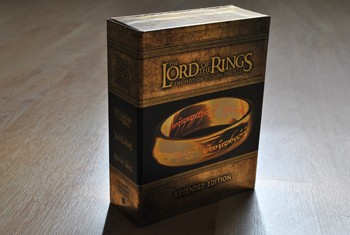 | 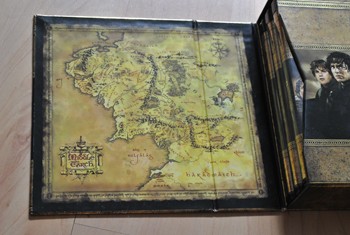 |
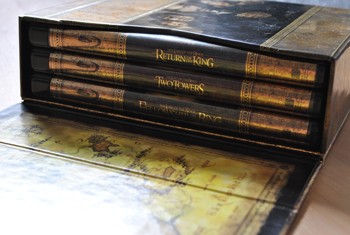 | 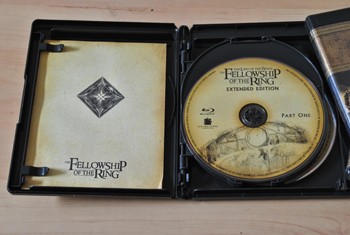 |
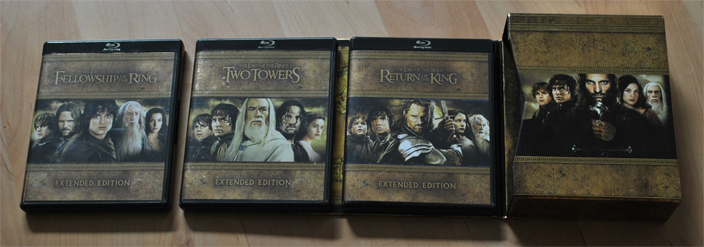
Ah, it's arrived. Warner Bros. and New Line Home Entertainment bring The Lord of the Rings: The Extended Motion Picture Trilogy in a fifteen-disc set, containing six Blu-rays for the films themselves and nine standard-definition discs. They're housed in three black slim-line five-disc cases, similar to the newer pressings of Blade Runner, while each one comes with a replication of the insignia-encrusted booklets from the book-style DVD presentations -- only they're made of a nice textured paper instead of slick, glossy stock. The three cases fit snugly within a sturdy cardboard box that plays off the book design of the original four-disc sets, while a "hidden" magnet holds the cases in-place by way of a flap that has a map of Middle-Earth printed on the front. The loose flap on the front might appear flimsy, but once the magnet's got everything latched together, it's sturdy enough.
Video aud Audio:
Our last trek through Middle-earth rendered a curious high-definition experience, one that presented the second and third installments in the Lord of the Rings Trilogy with outstandingly strong audiovisual acuity -- yet ultimately dropped the ball with the first, arguably finest film of the lot. How does Fellowship of the Ring fare in this extended edition? Far, far better, but not without a few curiosities. The 1080p AVC encode -- again framed at 2.39:1, like the rest of the trilogy -- has clearly seen a facelift in Warner Bros.' remastering department, showcasing a wider breadth of instinctive colors, a tighter grasp on detail in scenery and the costumes/production design, and a natural 24p flow that appears in-line with a film source instead of an artificially-hampered HD rendering. Skin tones come back to earth with an inherent pinkish hue, instead of the heightened reds from the theatrical disc, while the contrast in sequences offers deep, profound blacks that still allow details to sneak through -- a bit dark in a few scenes, but nothing that crushes out minutiae hiding in the shadows. Computer-generated scenery and effects stay stable against the image, while inborn fine detail in close-ups and in expansive nature shots reveals far more than the theatrical predecessor.
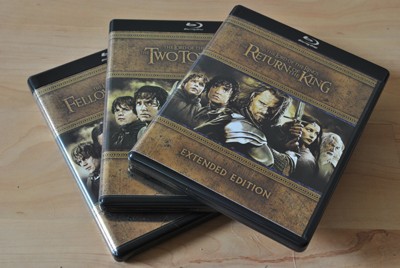 While the difference renders a drastic leap ahead, a few stretches in The Fellowship of the Ring do suffer from a peculiar issue; some heavier tints have been draped over the image, from green coloring in The Shire to a teal hue during Aragorn and the hobbits' initial hike. When submersed in the image from start to finish, it's not distracting and actually fits the visual manner of the sequences in which they take place, but comparing the releases side-by-side does offer some head-scratching palette choices that, even if approved by the filmmakers, appear overly concentrated. Something to bear in mind: these instances don't run the course of the entire film, as if the technicians helming the release just carelessly slathered colors atop the image. The majority of Fellowship actually looks extremely proportionate and agile to its aims, while suffering far less from any smoothness caused by noise reduction or other digital enhancement. Much like the previous set, though, it still stands as the least proficient of the trilogy in terms of actual high-definition satisfaction, as I still feel it could harness a higher sharpness density and render truer white levels. Yet this time around, it's actually a noticeably rewarding experience, even if it differs from the visual aesthetic we've come to know in regards to Peter Jackson's film.
While the difference renders a drastic leap ahead, a few stretches in The Fellowship of the Ring do suffer from a peculiar issue; some heavier tints have been draped over the image, from green coloring in The Shire to a teal hue during Aragorn and the hobbits' initial hike. When submersed in the image from start to finish, it's not distracting and actually fits the visual manner of the sequences in which they take place, but comparing the releases side-by-side does offer some head-scratching palette choices that, even if approved by the filmmakers, appear overly concentrated. Something to bear in mind: these instances don't run the course of the entire film, as if the technicians helming the release just carelessly slathered colors atop the image. The majority of Fellowship actually looks extremely proportionate and agile to its aims, while suffering far less from any smoothness caused by noise reduction or other digital enhancement. Much like the previous set, though, it still stands as the least proficient of the trilogy in terms of actual high-definition satisfaction, as I still feel it could harness a higher sharpness density and render truer white levels. Yet this time around, it's actually a noticeably rewarding experience, even if it differs from the visual aesthetic we've come to know in regards to Peter Jackson's film. None of these issues hamper The Two Towers and The Return of the King, however, both of which telegraph astounding, near-reference-level HD presentations that unfortunately put the first film's treatment to shame. Depth of field, fine textures in stone and close-ups, and the intricate costume, set, and production work all shine with a clear, snappy perspective, while still wrapping its complex blend of computer-generated and live-action photography with a convincing draping of film grain. Grand vistas project a ravishing level of awareness to the depth against mountains and during Frodo and Sam's drudge through the swamp, while the digitally-rendered heights of Minas Tirith project clean whites and a phenomenal eye for textural precision. The sheen on armors and upon swords grasp at exquisite metallic shimmers, whether caked with filth during the battle of Helm's Deep or shining lustrously during the battle outside the Black Gate, while the delicate depth within velvety costumes and the range of astonishing contrast during the tan, green, blue, and near-grayscale sequences remain stable and eye-opening. Moreover, any instances of overt noise reduction or distortion aren't noticeable in the ways they are in the theatrical presentation, rendering the film in a fashion highly unlikely to be bested in the coming years.
But as pleasing as the visual treatments are, they still stay a few steps behind from the 6-channel DTS HD Master Audio tracks, which are thunderously aggressive and, for lack of better words, faultless. Surround activity sweeps against the channels within all three films, from the piercing clank of blades to the thud of catapulted stone and the flurry of snow against mountaintops. Dialogue pours from appropriate with razor sharp awareness of the design's expansive atmosphere. Battles, battles and more battles populate the film, all exploding with their own lower-frequency aggressiveness where needed -- the blaring of a horn and slam of a steel shield at Amon Hen, the zip of arrows at Helm's Deep, and the robust thuds of oliphant feet and battering rams at Minas Tirith. Howard Shore's score sweeps across the entire sound-stage with floating, delicate notes and expanding musical cues, while all the sound effects make broad use of the expansive sound stage at all times. Remaining distortion free and aurally furious, as those who have heard the extended DVDs can attest, these Master Audio tracks retain their fervor from start to finish.
Special Features:
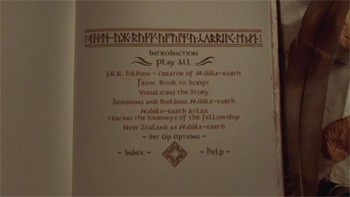 | 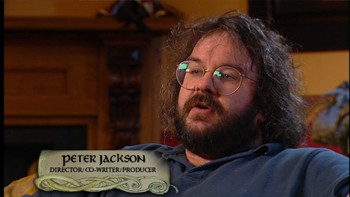 |
Sometimes, home-media reviewers -- lumping yours truly into that group -- like to use the word "trove" to describe a great deal of special features for a particular film. They all pale in comparison, however, to the Extended Edition content for The Lord of the Rings trilogy, which truly meets the qualification for a trove, a cornucopia, an endless, bottomless satchel of in-depth glimpses into the creation of the films. Therefore, it shouldn't come to any great surprise that no "new" special features have been assembled for this Blu-ray box set; instead, it opts for comprehensiveness across the two separate extended edition DVDs, both the initial book-style releases and the Costa Botes documentaries from the Limited Edition discs. There's one unfortunate catch: they appear exactly as they have previously, on a collection of three (3) DVDs instead of on a dedicated Blu-ray. Now, upscaling the content wouldn't offer much in resolution boosting, as much of it was shot in standard-definition; however, condensing them all onto one disc would make for a more seamless experience in exploring the extras, while enhancing the resolution to HD could've/would've enabled the usage of an elegant menu navigation using the Blu-ray's tech. Extensive reviews of the Extended Edition DVDs can be found here, here, and here at DVDTalk.
Audio Commentaries:
Each film arrives with all four commentaries in-tact, amounting to a grand total of twelve (!) tracks for play alongside the individual films. Each one comes with four individually categorized tracks: Director and Writers, the Cast, the Production Team, and the Design team. Viewers who gravitate to the visual-based supplements first will likely find the material in the audio tracks to be a bit redundant; however, the content's still detailed to a mystifying degree, with Jackson proving to be a worthy of delivery a commentary in much the same fashion as he does in his video interviews. As to be expected, the cast commentaries err away from in-depth exploration and more towards bubbly interactions, but that's what the other three tracks are for: core insight.
Also available on most of the six Blu-ray discs are a series of Easter Eggs available from the DVDs, accessible by sliding the home menu all the way over to an icon of The Ring; The Fellowship of the Ring offers the "Alternate" version of The Council of Elrond for the MTV Movie Awards (3:29, SD AVC) and the stellar Theatrical Preview of The Two Towers (3:34, HD AVC) that adorned the first film's theatrical release; The Two Towers tosses in the MTV Movie Awards Gollum Acceptance Speech (2:55, SD AVC) while Disc Two from the set doesn't arrive with one; and The Return of the King offer the Domonic Monaghan / Elijah Wood Prank Interview (8:59 , SD AVC) and the mildly aggravating MTV-based Ben Stiller and Vince Vaughn Pitch (5:50, SD AVC) for more Lord of the Rings sequels. Each one arrives with introductions from Peter Jackson (and Elijah Wood for one) at the start that congratulate the user for finding the easter egg -- which is kinda humorous now, since they're extremely easy to locate on the menu this time.
Appendices: Part 1 and 2 -- The Fellowship of the Ring
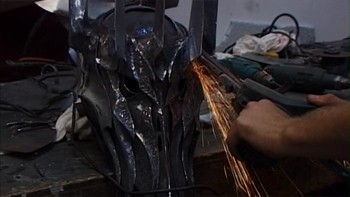 | 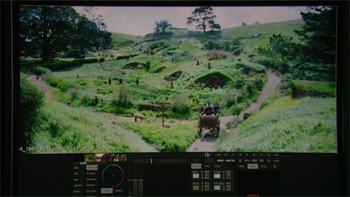 |
The content in the first reach in Peter Jackson's satchel of archives sets the tone for the entirety of the Extended Edition supplemental material, in that each pairing of appendixes tackles similar subjects and expounds upon them. However, for discussion about The Fellowship of the Ring, you're going to find more establishing content about finding the actors, scouting locations, starting the work at WETA workshop and designing the sound for the films. Each piece mixes very sober, candid interviews with director Jackson, the actors, cinematographer Andrew Lesnie, and the team of artists and production crew, alongside behind-the-scenes shots (some of Costa Botes' material) and side-by-side comparisons during the more visually intensive elaborations. You'll see how Tolkien artists Alan Lee and John Howe first plopped down at Bag End and started sketching out the infrastructure against the barren hills, how the sounds for The Watcher and Balrog were created, and how they WETA crew scanned scale models for use in their digital medium. Numbers like 45,000 pieces cranked out of WETA's physical wing and 3-4 million feet of film get tossed around, all while anecdotes about the actors meeting for the first time illustrates their camaraderie.
Appendix 1: From Book to Vision
| Appendix 2: From Vision to Reality
|
Appendices: Part 3 and 4 -- The Two Towers:
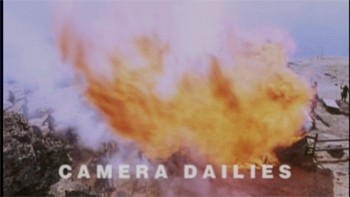 | 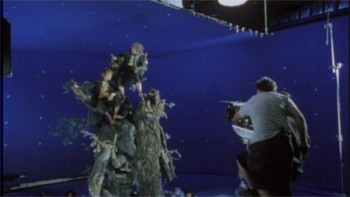 |
With a framework established, The Two Towers takes the same deft mix of interviews, clips from the film, and behind-the-scenes glimpses and carries forth at the same stride. Further discussion on J.R.R. Tolkien evokes the influence that war and his associates had upon his work, how writing The Two Towers was both easy due to a lack of need for character establishment and extremely difficult due to its complex lack of resolution and need to make changes for cinematic flow (as well as why Helm's Deep doesn't intercut with the spider battle in the third film, and how Arwen almost popped up during Helm's Deep), and how they creates the Dead Marshes out of a train-hampered parking lot. They also talk about building a nursery to care for transplanted foliage during the expensive construction of Rohan, the peculiarity of bearing in mind that Andy Serkis would become Gollum while shooting, while witnessing the pre-viz work at WETA Digital as they size up the warring Ents for their massive battle near the end of the film. Lengthy discussion falls on the numerous unit shoots during the "Cameras of Middle-earth" portion, which remains quite insightful for its length, while revisiting the sound creation and scoring labs keeps the same pace as the Fellowship versions of the same content. And the discussion over (half-)creating trees for a set is truly interesting.
Appendix 3: The Journey Continues
| Appendix 4: The Battle for Middle-earth Begins
|
Appendices: Part 5 and 6 -- The Return of the King:
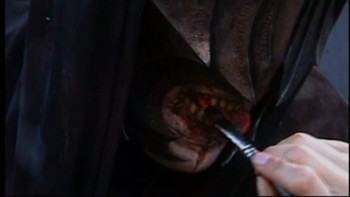 | 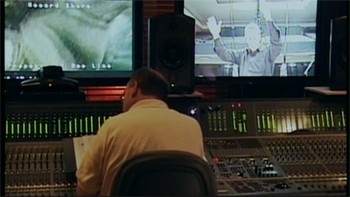 |
The interview and behind-the-scenes content feels familiar at this point, yet why change things up when they're this solidly illuminating? The Return of the King discovers topics such as a location Jackson reused from Dead Alive/Braindead, the Italian and French influences present in Minas Tirith's design, and reusing the Helm's Deep for constructing Minas Tirith -- and that's just all in one quadrant of the design portion. At this point, you're actually starting to recognize even lower-level faces in the production crew, watching as they recreate stone from styrofoam and their other magic, while endlessly soaking in the sketches that wash over narration of Tolkein's book. Jackson and Tolkein scholars discuss the timeline rearrangement of the end of the second to the beginning of the third, as well as tackling some touchy subjects for book purists and electing for a "tamer" version of Frodo's "Go home!" sequence. The WETA guys discuss referencing the Witch King back to the Nazgul from the first film and building a massive mace for him, as well as going in-depth into all different sorts of armor created and the blend of CG and prosthetic makeup for the Army of the Dead. And, of course,
Appendix 5: The War for The Ring
| Appendix 6: The Passing of An Age
|
Costa Botes Documentaries (4x3 Letterbox, Fifth Disc in Each Set):
Not a single clip from the film will be spotted in these lengthy behind-the-scenes documentaries from Jackson's Forgotten Silver partner Costa Botes, though a brief pre-visualization sequence might pop up to show exactly what the content's focusing on. These pieces -- in which you've seen a lot of the material, only in clips spliced in the original special features from the first extended DVD set -- mix a wealth of raw footage that reveals production elements, optical tricks, choreography, contingency maneuvers, and all-around shoddy luck that took place on the sets of the films, as well as how Jackson and his crew made the most of it on a consistent basis. Candid interviews, all done on-the-fly and without any kind of marketing motive, discuss things ranging from the number of swords created and how to helicopter elements in on-set to orchestrating toilets and trash removal. The material's also immaculately edited together to keep up a highly-insightful and ultimately accessible rhythm for just about any viewer, where you'll find yourself exclaiming, "Wow, that's impressive" quite often. Then, while you're taken aback by the revelations, you'll catch some off-hand comments and jovial laughter from the cast and crew, and back and forth again. There are way too many outstanding moments caught to really rattle them off, so all that can be said is that they're absolutely delightful must-watch exposes on constructing the films.
Final Thoughts:
Easily one of the most coveted releases to arrive on Blu-ray, Peter Jackson's extended glimpses at his Lord of the Rings Trilogy arrive in a fashion that present the riveting, epic-scaled tellings of J.R.R. Tolkien's books in grand fashion. They're immensely entertaining, deeply-felt entries in the genre and adaptations that tightly latch onto the essence of the novels, featuring a mix of practical production efforts and digital effects -- most of it under the WETA Workshop / WETA Digital umbrella -- into a stunning vision. These extended cuts of the films looks stunning in high-definition (the second and third more so than the first, which also sees an uptick in quality over the theatrical editions), while including all the special features from the initial Extended DVD release and the Limited Edition DVDs: commentaries, endless behind-the-scenes features, galleries, and the Costa Botes reels. While the choice against including the special features on a single Blu-ray disc per film might knock this set down a peg or two for some, the wealth of features and the presentations of these pictures still earns it DVDTalk's highest recommendation. Collector's Series.
|
| Popular Reviews |
| Sponsored Links |
|
|
| Sponsored Links |
|
|
| Release List | Reviews | Shop | Newsletter | Forum | DVD Giveaways | Blu-Ray | Advertise |
|
Copyright 2024 DVDTalk.com All Rights Reserved. Legal Info, Privacy Policy, Terms of Use,
Manage Preferences,
Your Privacy Choices | |||||||









